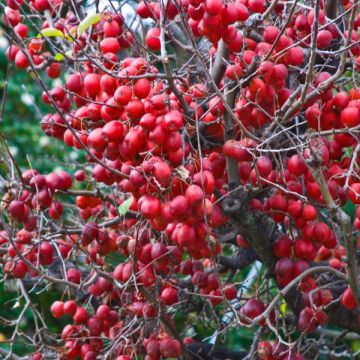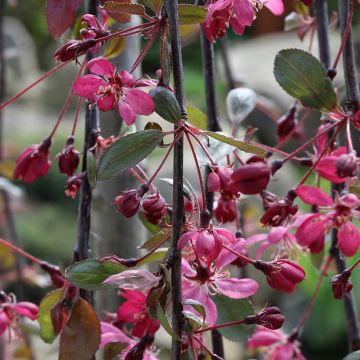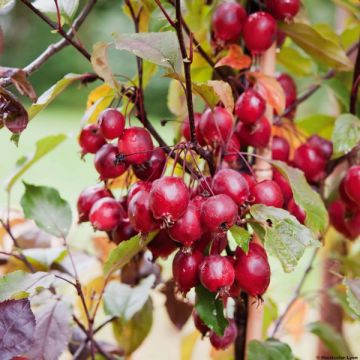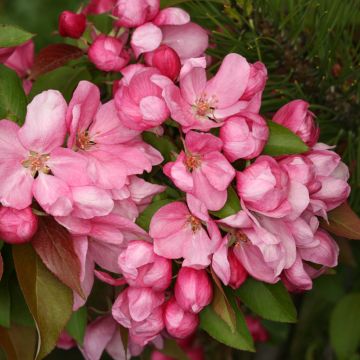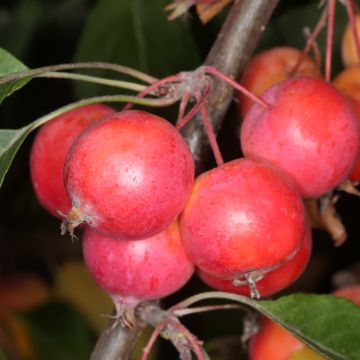

Malus sachalinensis Pendula - Crabapple


Malus sachalinensis Pendula - Crabapple
Malus sachalinensis Pendula - Crabapple
Malus sachalinensis Pendula
Crabapple
Special offer!
Receive a €20 voucher for any order over €90 (excluding delivery costs, credit notes, and plastic-free options)!
1- Add your favorite plants to your cart.
2- Once you have reached €90, confirm your order (you can even choose the delivery date!).
3- As soon as your order is shipped, you will receive an email containing your voucher code, valid for 3 months (90 days).
Your voucher is unique and can only be used once, for any order with a minimum value of €20, excluding delivery costs.
Can be combined with other current offers, non-divisible and non-refundable.
Why not try an alternative variety in stock?
View all →This plant carries a 24 months recovery warranty
More information
We guarantee the quality of our plants for a full growing cycle, and will replace at our expense any plant that fails to recover under normal climatic and planting conditions.
Would this plant suit my garden?
Set up your Plantfit profile →
Description
Malus sachalinensis 'Pendula' is a graceful weeping ornamental apple tree variety. In spring, its cascading branches evoke a fountain of white flowers. Autumn is the second highlight for this shrub, with the production of numerous small yellow-orange fruits grouped in clusters, which will continue to be a spectacle until winter. With its moderate growth, this variety is perfectly suited for small gardens. Hardy and adaptable, it thrives in sunny locations and can adapt to most soils.
Ornamental Apple Trees are derived from various botanical species of the genus Malus belonging to the large botanical family Rosaceae. Hardy, accommodating, and easy to grow, ornamental apple trees are happy with ordinary soil but prefer loamy, deep, loose, and moist soil as well as sunny exposures. Once established, they can tolerate neglect while maintaining their generous character. Numerous cultivars have emerged in both Europe and the United States, each bringing its own touch of originality.
Malus sachalinensis 'Pendula' is a shrub consisting of a trunk onto which a specific variety has been grafted, selected for its long weeping branches. For this reason, the final height of the plant depends on the height of the stem. It can vary from 2m to 4m. Its slightly irregular crown is composed of straight branches that cascade towards the ground. They tolerate pruning well. To increase the diameter of the crown, an annual pruning in March is recommended. The leaves of this apple tree are elliptical, elongated, dark green, and velvety on the underside. It flowers abundantly in April-May, depending on the climate. The flowers are white with a slight touch of pink on the edges. They are cup-shaped, composed of 5 petals, and measure 3 to 4 cm in diameter. After pollination by bees, small round to oval fruits, measuring approximately 1 cm in diameter, form. They turn yellow-orange, or even reddish-orange, in late summer. They are sought after by certain birds. The foliage turns yellow in autumn before falling.
Malus sachalinensis 'Pendula' is perfectly suited for small urban or romantic-style gardens. It can be planted as a single specimen on a lawn or in the centre of a bed surrounded by low plants, perennials, or creeping shrubs to highlight its architecture. A carpet of White Aubrieta Kitte White at its base will harmonize with its snow-white flowering. At its feet, Japanese Forest Grass with its changing colours and undulating foliage will also create a beautiful setting. To extend the flowering season, consider Masterworts, whose white, pink, or violet flowers bloom from June to late summer. Autumn Asters, which offer an extended colour palette, also bloom late in the season.
Malus sachalinensis Pendula - Crabapple in pictures


Plant habit
Flowering
Foliage
Botanical data
Malus
sachalinensis
Pendula
Rosaceae
Crabapple
Cultivar or hybrid
Other Malus - Crabapple
View all →Planting and care
Easy to grow in ordinary soil, Malus sachalinensis 'Pendula' requires a bright and sunny exposure to flower well. Ornamental Malus trees are generally very accommodating, but they prefer fertile, moist and deep soil. After careful planting and regular watering during the first two years, they can fend for themselves. Plant it in full sun or partial shade, giving it room to spread. Dig a large planting hole. If the soil is poor, add compost to the planting soil and apply fertilizer or compost at its base every spring. Pruning is not necessary, as this flowering apple tree naturally takes on a weeping habit. To prevent diseases, especially scab, treat with Bordeaux mixture in the spring.
Planting period
Intended location
Care
Planting & care advice
This item has not been reviewed yet - be the first to leave a review about it.
Similar products
Haven't found what you were looking for?
Hardiness is the lowest winter temperature a plant can endure without suffering serious damage or even dying. However, hardiness is affected by location (a sheltered area, such as a patio), protection (winter cover) and soil type (hardiness is improved by well-drained soil).

Photo Sharing Terms & Conditions
In order to encourage gardeners to interact and share their experiences, Promesse de fleurs offers various media enabling content to be uploaded onto its Site - in particular via the ‘Photo sharing’ module.
The User agrees to refrain from:
- Posting any content that is illegal, prejudicial, insulting, racist, inciteful to hatred, revisionist, contrary to public decency, that infringes on privacy or on the privacy rights of third parties, in particular the publicity rights of persons and goods, intellectual property rights, or the right to privacy.
- Submitting content on behalf of a third party;
- Impersonate the identity of a third party and/or publish any personal information about a third party;
In general, the User undertakes to refrain from any unethical behaviour.
All Content (in particular text, comments, files, images, photos, videos, creative works, etc.), which may be subject to property or intellectual property rights, image or other private rights, shall remain the property of the User, subject to the limited rights granted by the terms of the licence granted by Promesse de fleurs as stated below. Users are at liberty to publish or not to publish such Content on the Site, notably via the ‘Photo Sharing’ facility, and accept that this Content shall be made public and freely accessible, notably on the Internet.
Users further acknowledge, undertake to have ,and guarantee that they hold all necessary rights and permissions to publish such material on the Site, in particular with regard to the legislation in force pertaining to any privacy, property, intellectual property, image, or contractual rights, or rights of any other nature. By publishing such Content on the Site, Users acknowledge accepting full liability as publishers of the Content within the meaning of the law, and grant Promesse de fleurs, free of charge, an inclusive, worldwide licence for the said Content for the entire duration of its publication, including all reproduction, representation, up/downloading, displaying, performing, transmission, and storage rights.
Users also grant permission for their name to be linked to the Content and accept that this link may not always be made available.
By engaging in posting material, Users consent to their Content becoming automatically accessible on the Internet, in particular on other sites and/or blogs and/or web pages of the Promesse de fleurs site, including in particular social pages and the Promesse de fleurs catalogue.
Users may secure the removal of entrusted content free of charge by issuing a simple request via our contact form.
The flowering period indicated on our website applies to countries and regions located in USDA zone 8 (France, the United Kingdom, Ireland, the Netherlands, etc.)
It will vary according to where you live:
- In zones 9 to 10 (Italy, Spain, Greece, etc.), flowering will occur about 2 to 4 weeks earlier.
- In zones 6 to 7 (Germany, Poland, Slovenia, and lower mountainous regions), flowering will be delayed by 2 to 3 weeks.
- In zone 5 (Central Europe, Scandinavia), blooming will be delayed by 3 to 5 weeks.
In temperate climates, pruning of spring-flowering shrubs (forsythia, spireas, etc.) should be done just after flowering.
Pruning of summer-flowering shrubs (Indian Lilac, Perovskia, etc.) can be done in winter or spring.
In cold regions as well as with frost-sensitive plants, avoid pruning too early when severe frosts may still occur.
The planting period indicated on our website applies to countries and regions located in USDA zone 8 (France, United Kingdom, Ireland, Netherlands).
It will vary according to where you live:
- In Mediterranean zones (Marseille, Madrid, Milan, etc.), autumn and winter are the best planting periods.
- In continental zones (Strasbourg, Munich, Vienna, etc.), delay planting by 2 to 3 weeks in spring and bring it forward by 2 to 4 weeks in autumn.
- In mountainous regions (the Alps, Pyrenees, Carpathians, etc.), it is best to plant in late spring (May-June) or late summer (August-September).
The harvesting period indicated on our website applies to countries and regions in USDA zone 8 (France, England, Ireland, the Netherlands).
In colder areas (Scandinavia, Poland, Austria...) fruit and vegetable harvests are likely to be delayed by 3-4 weeks.
In warmer areas (Italy, Spain, Greece, etc.), harvesting will probably take place earlier, depending on weather conditions.
The sowing periods indicated on our website apply to countries and regions within USDA Zone 8 (France, UK, Ireland, Netherlands).
In colder areas (Scandinavia, Poland, Austria...), delay any outdoor sowing by 3-4 weeks, or sow under glass.
In warmer climes (Italy, Spain, Greece, etc.), bring outdoor sowing forward by a few weeks.

































